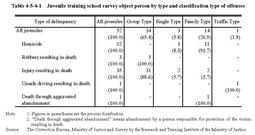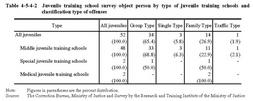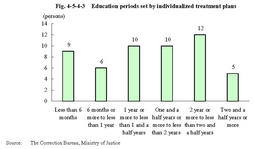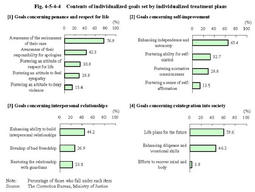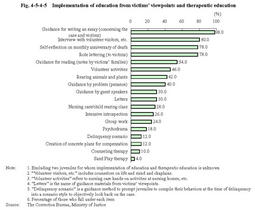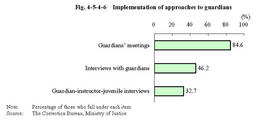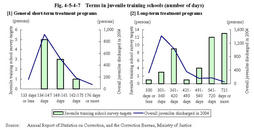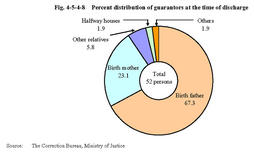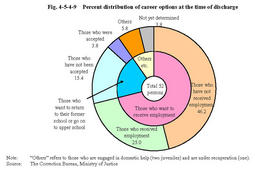| Previous Next Index Image Index Year Selection | |
|
|
1 Treatment at juvenile training schools (1) Attribution of juvenile training school survey object person Among278object person,123juveniles(44.2%)were committed to juvenile training schools,among which90serious juvenile offenders aged16or over referred to public prosecutors in principle were committed to juvenile training schools(including10who were transferred to family courts as a result of district court proceedings after prosecution and were committed to juvenile training schools from family courts).76(84.4%)were committed to middle juvenile training schools,nine(10.0%)to special juvenile training schools,and five(5.6%)to medical juvenile training schools.Among76juveniles committed to middle juvenile training schools,11(14.5%)were placed under general short-term treatment program and65(85.5%)were placed under long-term treatment program.Among90serious juvenile offenders aged16or over referred to public prosecutors in principle that were committed to juvenile training schools,52(57.8%)were discharged by the end of March2005.
As for these52juveniles discharged from juvenile training schools(hereinafter referred to as"juvenile training school survey object person"),we analyzed what kind of treatment plans were made and how the treatment was implemented,based on data by the Correction Bureau,Ministry of Justice. Among these52juvenile training school survey object person,43(82.7%)were males and nine(17.3%)were females. Table4-5-4-1 shows juvenile training school survey object person by type and classification type of offenses. Table4-5-4-1 Juvenile training school survey object person by type and classification type of offenses Table4-5-4-2 shows juvenile training school survey object person by type of juvenile training schools and classification type of offenses.48juveniles(92.3%)were committed to middle juvenile training schools.Two Family Type juvenile offenders committed to medical juvenile training schools were suspected to have a personality disorder and an atypical mental disorder.There was one discharged juvenile who was initially committed to a middle juvenile training school,where he was diagnosed to have psychogenic reaction and was transferred to a medical juvenile training school. Table4-5-4-2 Juvenile training school survey object person by type of juvenile training schools and classification type of offenses (2) Contents of individualized treatment plans Individualized treatment plans are made according to recommendations of general short-term treatment programs by family courts or fully respecting the effect of other recommendations by family courts. Fig.4-5-4-3 shows education periods set by individualized treatment plans.
For nine juveniles for whom family courts recommended general short-term treatment programs,education periods shorter than six months were set.For many juveniles,family courts recommended detention for two to three years.Their education periods varied up to three years. Fig.4-5-4-3 Education periods set by individualized treatment plans Fig.4-5-4-4 shows the contents of individualized goals set by individualized treatment plans.Education periods and individualized goals set at the time of admission may be amended or changed,being reviewed any time as needed,when attainment of the goals seems to be difficult or there are changes in environments for protection.Among juvenile training school survey object person,for juveniles,such as one who incurred a mental disorder due to a psychogenic reaction and was transferred from an ordinary juvenile training school to a medical one,the contents of individualized treatment plans were amended and changed. Fig.4-5-4-4 Contents of individualized goals set by individualized treatment plans (3) Implementation of education At juvenile training schools,it is considered especially important for serious juvenile offenders to attain individualized education goals,such as developing the awareness of the seriousness of their case and their responsibility to offer apologies to their victims.
Fig.4-5-4-5 shows implementation of education from victims'viewpoints and therapeutic education. Lectures by crime victims or bereaved families were given to10juveniles(19.2%)out of52juvenile training school survey object person.Furthermore,various education methods were implemented for these juveniles,such as personal interviews by individual assigned teachers and guidance for writing a diary,etc. Fig.4-5-4-5 Implementation of education from victims'viewpoints and therapeutic education Fig.4-5-4-6 shows implementation of approaches to guardians.The percentage of those whose guardians received approaches at guardians'meetings was the highest at84.6%.Interviews with guardians and guardian-instructor-juvenile interviews were also held as a means of personal approaches.Active approaches seem to be taken for guardians who did not attend guardians'meetings,making much of opportunities such as their visits to their child.For a juvenile who had had big troubles with his parents,due to his mother's unstable mentality,and killed his brother,family counseling was regularly implemented for the juvenile himself and his family. Fig.4-5-4-6 Implementation of approaches to guardians In treatment processes,most juveniles reflect on themselves,improve through various kinds of encouragement at juvenile training schools,and get discharged.However,all those who got high treatment grades at the time of discharge were not in desirable conditions when they were admitted in juvenile training schools.Right after juveniles enter training schools,they often attribute their case to their accomplices,show a negative attitude towards everything,due to being too conscious of their problem of being too easily aligned with the others around them,or complain about their long detention term.However,they come to show a significant improvement in their behavior and attitude through guidance by instructors and interaction with their guardians.The following are major examples of juveniles whose significant problems made their treatment very difficult. (i) A case of injury resulting in death by a juvenile who had a strong tendency to release stress by violence(a Group Type male) A juvenile synchronously got involved in a case of group injury resulting in death led by an adult and was committed to a special juvenile training school.
He was easily affected by his surrounding conditions also after entering the juvenile training school and breached the discipline by using violence toward instructors.He had been at the mercy of his violent father with a bad drinking habit since he was a child.He had developed a personality to easily get daunted but learned to make a bluff to hide his weakness and release his stress by violence. Continuous counseling by outsiders was implemented to this juvenile to stabilize him emotionally and prompt him to recognize his problem of easily resorting to violence.As a result,he came to lead a life in countenance.He offered a concrete plan for compensation to the victim's bereaved family through guidance by a lawyer.As his offer was accepted,he confirmed his determination to pay the settlement with sincerity. (ii) A case of injury resulting in death by a juvenile who had a strong tendency to follow the crowdeasily and could not reflect on himself sufficiently(a GroupType male) A juvenile got involved in a case of injury resulting in death by using violence in a group on the victim,who was suspected to have spoken ill of a playmate,and was committed to a middle juvenile training school.
He showed a strong tendency to easily follow inmates with bad life styles in the dormitory and repeated breaches of discipline.He was overly sensitive as he had felt lonely,unable to be dependent on his working parents.He was too stubborn to be dependent on adults amenably in spite of his dependence orientation,and was apt to follow his peers. The juvenile was made to participate in group work to think about crime victims,and his assigned teacher personally interviewed him repeatedly.During these procedures,he experienced his father's death and came to show a positive attitude to review relationships with his parents.He gradually developed a sense of responsibilities and came to exercise his leadership. (iii) A case where a juvenile was apt to heighten anxiety in a difficult situation(a Group Type female) A juvenile followed her adult accomplice to get involved in a case of robbery resulting in death and was committed to a middle juvenile training school.
At first she was positive about life in the juvenile training school,but gradually became unstable emotionally,obsessed by pessimistic feelings,and came to suffer marked anorexia.She was originally slow in everything and was awkward.However,raised as a bother by a nervous father and a mother with less peace of mind,she obviously lacked in abilities to address reality by herself and showed a strong tendency to feel anxiety easily. Prioritizing consideration towards psychiatric treatment,this juvenile was transferred to a medical juvenile training school for intensive psychiatric therapy by a psychiatrist,and was sent back to the original juvenile training school after her symptoms relieved.She continued to complain about her physical disorders frequently and took rest in a private room for some time even after that.However as a result of continuous efforts,such as interview guidance with her and her guardians,an improvement was observed in their family relationships,which encouraged her to confirm her determination to expiate her guilt with her parents.She came to make a handwritten copy of a sutra for the victim's soul. (iv) A case where a juvenile was apt to strengthen negative emotions in side of himself(a Family Type male) A juvenile killed his birth father,who used violence on his family,and was committed to a middle juvenile training school.
After entering the juvenile training school,he continued problematic behaviors,such as hurting himself,swallowing foreign bodies,and tying up strips of sheets and towels,saying"I am making preparations to kill myself whenever something bad happens."He showed a strong victim mentality and self-hatred and could not cope with these negative emotions,only to strengthen them inside of himself. Prioritizing consideration towards psychiatric treatment,this juvenile was transferred to a medical juvenile training school for an appropriate treatment.At the medical juvenile training school,psychiatric therapy by a psychiatrist was implemented intensively,as well as adopting such methods as psychodrama and triangular interviews with his guardians and his assigned teacher.As a result,he gradually gained emotional stability and came to tell his real feelings to school staff and express his complaints in a diary.However,there remained a slight uncertainty whether he would be able to release his stress in an appropriate way even after he left school. The level of heinousness of cases is not always proportional to that of the difficulty in treating juveniles in juvenile training schools.The difficulty in the treatment in juvenile training schools rather increases due to deep-rooted problems in juveniles'attribution and insufficient support from their families.In particular,juveniles often have strong dependence on others that easily leads them to group delinquency,and are emotionally immature,which had long been neglected in their complicated family environment.Due to these attributes,some of them cannot adjust themselves to group treatment in juvenile training schools,and repeat problematic behaviors such as breaches of discipline and attempted suicides.For these problematic juveniles,intensive individualized treatment is implemented by a team of several instructors,and other various approaches are taken,such as extension of their education term and transfer to other juvenile training schools.Juveniles are discharged only when an improvement in their problems is sufficiently confirmed. (4) Discharge All of those52juveniles were granted provisional discharge. Fig.4-5-4-7 shows their terms from admission to discharge.
Nine juveniles placed under general short-term treatment programs were all discharged within half a year.Many of the43juveniles placed under long-term treatment programs have been in juvenile training schools for considerably longer terms,compared to detention terms of overall juveniles discharged in2004. Fig.4-5-4-7 Terms in juvenile training schools(number of days) Fig.4-5-4-8 shows the percent distribution of guarantors at the time of discharge.Figures include those for whom positive adjustment was made for their places to return to,such as a juvenile who returned to his grandmother's house far away from home in order to cut off relationships with an organized crime group. Fig.4-5-4-9 shows career options at the time of discharge. Many juveniles wanted to receive employment,but only25.0%of them could.Among those who wanted to return to their former school or go on to upper school,only3.8%were accepted. Fig.4-5-4-8 Percent distribution of guarantors at the time of discharge Fig.4-5-4-9 Percent distribution of career options at the time of discharge |
